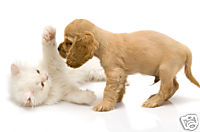 Loading... Please wait...
Loading... Please wait...Categories
Popular Brands
Our Newsletter
- Home
- Six Tips To Help Pet Owners Keep Fido Fluffy And Fit...
Six Tips To Help Pet Owners Keep Fido Fluffy And Fit...
1. With your vet, determine the optimum weight for your pet Every  pet is different, so work closely with your trusted veterinarian to determine your pet’s optimal weight. Rapid, unexplained weight gain may be a warning sign indicating a number of health issues, ranging from excess fluid retention due to kidney problems, to a hormone imbalance caused by any number of medical conditions.
pet is different, so work closely with your trusted veterinarian to determine your pet’s optimal weight. Rapid, unexplained weight gain may be a warning sign indicating a number of health issues, ranging from excess fluid retention due to kidney problems, to a hormone imbalance caused by any number of medical conditions.
2. Feed treats responsibly According to the American Pet Products Manufacturers Association, 88 percent of dog owners and 65 percent of cat owners give treats to their pets. Many treats are filled with fat and empty calories. In pets, like humans, extra calories attribute to excess weight and obesity that affects overall health. The calories in treats add up quickly, with many ranging between 50-100 calories each.
While owners are showing their love and affection with treats, the National Research Council of the National Academy of Sciences estimates that 25% of dogs and cats are overweight. Treats are largely expendable calories, but healthy treats like PetAg’s VIVE Low-Calorie Nutrition Bars offer a healthy low-fat, low-carb, high-fiber solution. Remember, a calorie-free good pat and praise shows love, too.
3. Read labels on pet food You may not realize that many treats and pet foods list their ingredients and the kcals (kilocalories—calorie measurement for pets), but calories are not required on treat labels. One medium-sized dog biscuit from a leading brand has 45 kcals versus 34.8 kcals for the same portion size of VIVE Low Cal Nutrition Bar, or 25% fewer calories. For daily caloric requirements, see the charts attached.
4. Substitute fruits and vegetables for treats These high fiber substitutes are also packed with nutrients good for cats and dogs, but remember to cut in portion sizes that are suitable for your size of pet. VIVE Low-Cal Nutrition Bars, with real pumpkin, apples and cranberries, are a healthy option that dogs enjoy.
5. Move! Again, think of yourself when trying to help your pet lose or maintain its optimum weight. Move food dishes for cats to higher levels so they’ll have to jump to reach them. Take your dog on an extra walk each day with a comfortable leash … it’s good for you and for your furry friends. Keep in mind, however, health-related issues that might affect your pet (i.e., a cat with joint problems might need steps to climb up to dishes and a dog with the same challenge might only go for an amble on warmer days outside).
6. Stop sharing your table scraps Dogs and cats have different nutritional and digestion needs, so while they may enjoy lapping up your leftovers, those same treats contribute extra calories to their diets and can attribute to their expanding waistlines. Studies have shown that a pet living on a lean diet can live up to two years longer than a pet that is constantly overfed either with its regular diet or with treats and table scraps.
We hope that you have found this guide to be of help to you and your "best friend"!

















